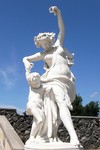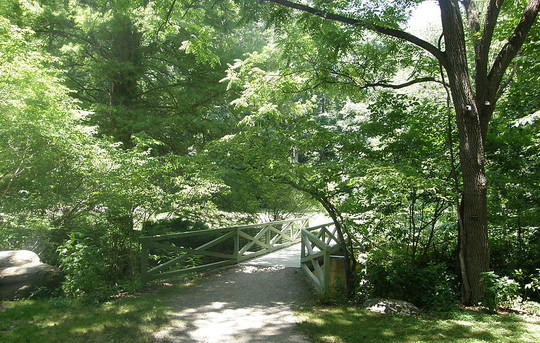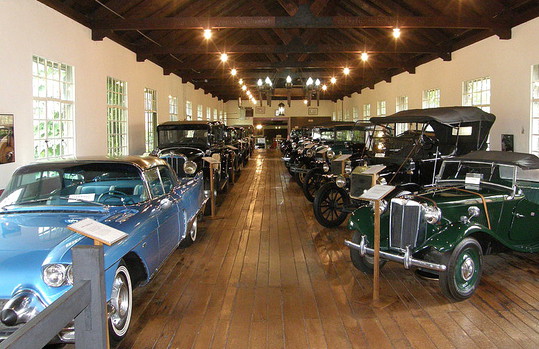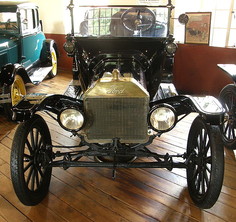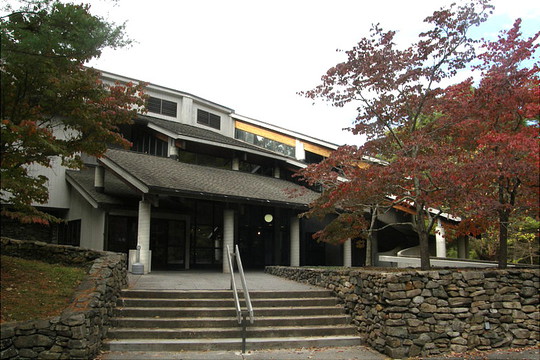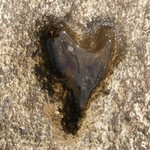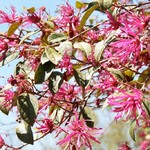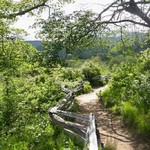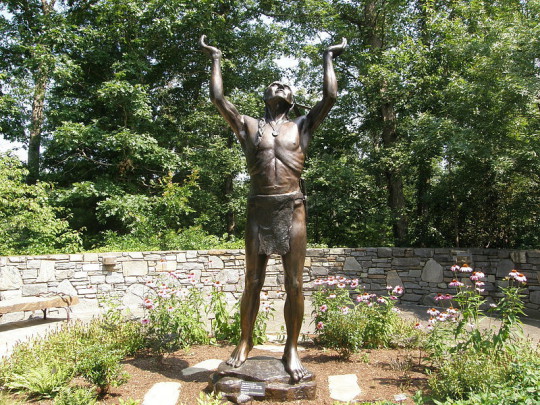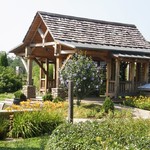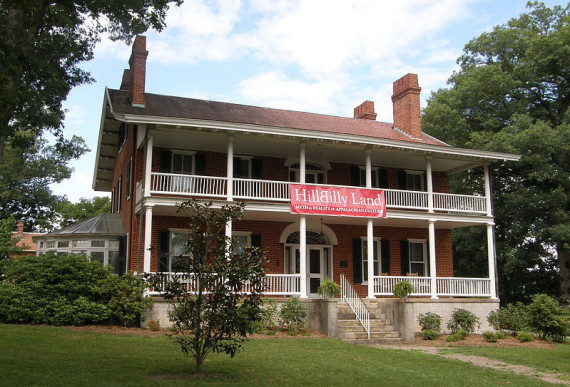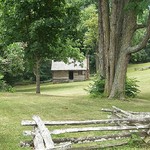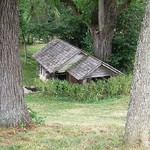BUNCOMBE COUNTY
This page features the following Buncombe County attractions/points of interest:
Biltmore Estate and Gardens, Blue Ridge National Heritage Area Visitor Center, Botanical Gardens of Asheville, Estes-Winn Antique Auto Museum, Folk Art Center/Southern Highland Craft Guild, Mount Pisgah, North Carolina Arboretum, Biltmore Industries Homespun Museum, Smith-McDowell House, Swannanoa Valley Museum, Thomas Wolfe Memorial State Historic Site, Western North Carolina Nature Center, Zebulon B. Vance Birthplace State Historic Site
Fast facts about Buncombe County:
Created in 1791, the county is named for Colonel Edward Buncombe, a Revolutionary War officer.
The county seat is Asheville, named for Samuel Ashe, a North Carolina governor. Other communities include Biltmore Forest, Black Mountain, Enka, and Weaverville.
Buncombe County’s land area is 655.99 square miles; the population in the 2010 census was 238,318.
It is worth noting that Biltmore in Buncombe County is the largest private home in the country.
Asheville
Biltmore Estate in Asheville is such a well-known North Carolina landmark that it hardly needs additional publicity. Its reputation is well deserved, however, and Biltmore would make almost everyone’s short list of “must see” Tar Heel attractions. A Charlotte Observer feature several years ago listed Biltmore as one of the “Seven Wonders of the Carolinas” and National Geographic Traveler calls it one of America’s national wonders. In truth, no amount of superlatives will do it justice. If you’ve never been, you owe it to yourself to find out why it rates such high praise. If you’ve not been in a while, you’ll find new activities have been made available. The largest privately-owned house in America was home to George and Edith Vanderbilt.
The estate was originally intended to be a “modest home on a mountain ridge.” Richard Morris Hunt, the most acclaimed architect of his day, soon expanded upon the original vision, however, and with the approval of his clients, he oversaw the construction of the most auspicious home in America. Begun in 1890, the house was under construction for five years and employed hundreds of workers and artisans from across America. It incorporated the most modern technology – central heating, refrigeration, plumbing, and electricity. Upon completion in 1895, Vanderbilt's "modest" mansion included four acres of floor space, 250 rooms – including 31 guest bedrooms – and 65 fireplaces!
Visitors should plan on spending at least one full day at Biltmore to really get a feel for the place. America's largest house is exactly what it claims to be -- large -- and it will take several hours to explore it at a comfortable pace, allowing time to appreciate all there is to be seen. The one-day package includes daytime admis-sion to the house, gardens, and winery and an audio tour. With the audio tour, you’ll be able to stroll through the chateau at your own speed, spending as much time as you like in such incredible rooms as the Palm Court, with its domed skylight; the magnificent 20,000-volume library; the masculine billiard, smoking, and gun rooms; the elegant Tapestry Room; and the cavernous Banquet Hall. The tour includes rooms on four floors, exhibiting priceless paintings, tapestries, rugs, sculptures, and other works of art collected by the Vanderbilts from around the world. Many personal family items can be seen as well. The downstairs portion includes a gymnasium, bowling alley, indoor swimming pool, and the areas where the house staff lived and worked.
After finishing the main house, guests should also plan on spending time in the meticulously landscaped gardens. Just as the house was designed by the most respected architect of his time, the gardens were likewise planned by the master of naturalistic landscaping, Frederick Law Olmsted. His plans for Biltmore incorporated a variety of styles. The Library Terrace, offering a view of Mt. Pisgah in the distance, is covered with wisteria and trumpet creeper vines. The focus of the Italian Garden is upon the architectural beauty of its three formal pools. The Shrub Garden, a winding path connecting the Italian Garden with the English Walled Garden, is surrounded by azaleas, dogwoods, Japanese maples, and flowering shrubs.
The 4-acre Walled Garden is the one most seen in photographs. A true flower garden, it contains no statues or fountains. From spring through fall, the gardens are awash in colorful blooms. Biltmore Estate is open year-round. Prices vary seasonally and by day of the week. Consult the website for specific fees. In addition to the one-day admissions, a variety of other opportunities are available, including specialty tours, behind the scenes tours, and twelve-month passes. 800-411-3807
Asheville
The Blue Ridge National Heritage Area Visitor Center occupies a spacious new building at Milepost 348 on the Blue Ridge Parkway [BRP] and serves as a hub for a broad assortment of cultural attractions in Western North Carolina. Along with information about attractions, food, and lodging, the Visitor Center/Destination Center features small exhibits relating to the history and heritage of the Parkway and the region. The 22-foot I-Wall is an interactive map of the entire BRP providing information about places to visit on or near the Parkway. A 24-minute movie entitled “The Blue Ridge Parkway – America’s Favorite Journey” is shown in the 70-seat theater. A 1.2 mile loop trail starts at the Visitor Center parking lot and connects with the slightly longer Mountains-to-Sea Trail. The Center is open 9-5 daily. Closed Thanksgiving Day, Christmas Day, and New Year’s Day. 828-298-5330
Asheville
The Botanical Gardens of Asheville is a 10-acre site adjacent to the campus of the University of North Carolina at Asheville. The Gardens were begun in 1960 when a group of local garden clubs and concerned citizens joined together in an effort to provide a place where many species of native plants unique to the area could flourish. Nationally recognized landscape architect Doan Ogden designed the layout of the Gardens, which are home to more than 600 plant species. The bloom season begins in mid-March and extends well into fall. Focal points along the half-mile loop trail include the Hayes Cabin, a dog-trot cabin relocated from Madison County; the Sycamore and Sunshine Meadows; a gazebo; three foot bridges; and the Wilson Bird Garden. A portion of the trail runs along Reed Creek. Elsewhere on the trail, visitors will pass the remnants of earthworks constructed during the Battle of Asheville, which took place in April, 1865. The Botany Center, located near the parking area, includes plants for sale and a variety of garden-related items. The Gardens are open daily, year-round, during daylight hours. Admission is free. 828-252-5190
Asheville
The Estes-Winn Antique Car Museum in Asheville showcases twenty vintage automobiles, ranging from a 1913 Model T Ford to the 1959 Edsel, and including such all-but-forgotten makes as R.E.O., Willys Overland, and Chandler. How the discovery of a moonshine still led to the establishment of an antique car exhibit is an interesting story folks at the Estes-Winn Museum like to tell. Local auto dealer Harry Blomberg came to the weaving house of the old Biltmore Woodworking and Homespun Industries looking to buy a table. What caught his fancy, however, was an old copper moonshine still, although just why a bootlegger’s still was on the property in the first place remains a mystery. Owners Alec Gover and Fred Seely, Jr. agreed to sell the still on one condition – that, along with the still, Blomberg buy the 20 acres of land and six buildings that once comprised Biltmore Industries. In 20 minutes, the deal was done. Blomberg actually reopened the weaving shop, but he did so using an adjacent building. The original weaving shop, which had once held 40 Scottish fly-shuttle looms, was cleared out to make room for his private automobile collection.
Today, 20 finely maintained vintage automobiles are on display, along with the moonshine still. Unlike the still, however, all the cars are fully operable and are taken out for a spin every three months. Appropriately, the earliest on exhibit is a 1913 Ford Model T. Affectionately known as the “Tin Lizzie,” it was this automobile that put America on the road. Over 16 million Model T’s were sold from 1909 to 1927. The car averaged 25 to 30 miles per gallon and could attain speeds of 40 to 45 miles per hour.
The most recent vehicle on display is a 1959 champagne-colored Edsel Corsair. Sporting its trademark horse-collar shaped chrome radiator, this Ford automobile proved considerably less appealing to the general populous than its forerunner. Several all-but-forgotten makes are exhibited, including a 1916 Overland, produced by the Willys-Overland Company of Toledo, Ohio. Together with Ford, Willys-Overland was responsible for the production of the general purpose vehicles – “jeeps” – used by the army during World War II. Another is a 1922 R.E.O. “Flying Cloud” touring automobile, manufactured by Ransom Eli Olds after he left Oldsmobile in 1904. From 1925, there’s a 4-door Dodge Brothers touring automobile. Horace and John Dodge were fired from Ford in 1915 and soon began their own company. By 1928, they were producing 1,000 automobiles a day. They sold their company that year to William Chrysler.
Another rare automobile on display is a 1928 Chandler. The Chandler Motor Car Company operated out of Cleveland, Ohio from 1913 to 1929. Sometime around 1920, Chandler employed a young fellow named Bob Hope to work the night shift in the parts department. Bob and some of his night shift buddies formed an informal barbershop quartet and would occasionally record their harmonies on the company Dictaphone machine. One night, they forgot to dispose of what they had recorded. The following morning, the owner heard their songs – and some disparaging comments they had made about him – and Hope’s career at Chandler came to an end shortly thereafter. All this is told in a letter signed by Bob Hope and posted to the window of the 4-door Chandler sedan. The museum is located adjacent to the Grove Park Inn. Once on the Inn property, follow the signs to the antique car museum. Hours are 10-5 Monday-Saturday and 1-5 Sunday from April through December. Closed January through March. Admission is free; donations appreciated. 828-253-7651
Asheville - Milepost 382 on Blue Ridge Parkway
The Folk Art Center/Southern Highland Craft Guild is an ideal place to spend both some time and some money. Located at Milepost 382 of the Blue Ridge Parkway near Asheville, this spacious, inviting facility includes main gallery exhibitions and focus gallery exhibitions that exhibit the works of regional artisans. The craft shop is full to overflowing with a variety of traditional and contemporary crafts by over 200 Guild members that visitors may purchase. 828-298-7928
West of Asheville on Blue Ridge Parkway
Mount Pisgah is about a 30-minute drive west of Asheville along the Blue Ridge Parkway. It takes its name from the biblical mountain from which Moses, after a 40-year sojourn in the wilderness, first saw the Promised Land. Views from this North Carolina summit may not elicit quite the same jubilation that the prophet experienced, but odds are you’ll still feel exhilarated by the climb and well rewarded for your efforts. The peak rises 5,721 feet, and the sights from the observation deck are spectacular. On clear days it’s easy to spot the Pisgah Inn, Cold Mountain, and stretches of the Parkway to the south. Asheville and Mt. Mitchell are visible to the north. The panoramic view from the top is slightly marred on the west by the transmission tower for Asheville’s WLOS-TV, but this 339-foot antenna somehow seems a little less obtrusive when one discovers that, at 6,023 feet above sea level, it has the distinction of being the highest television broadcast tower east of the Mississippi. The trail to the summit is 1.5 miles one way, and though it starts off at an easy upward slope, it gets increasingly steep and strenuous. The last half mile of the rocky trail is the most challenging, and you’ll want to wear good walking shoes. In late spring, when the mountain laurel and rhododendron are in bloom, the trail is nothing short of beautiful. In October, when the leaves display their most brilliant colors, the hike up the mountainside is simply breathtaking.
Mount Pisgah was once a part of a large tract of land owned by George W. Vanderbilt, who was also responsible for building the famous Biltmore Estate in Asheville. Vanderbilt had Buck Spring Lodge built below the summit of Mount Pisgah, near where today’s Pisgah Inn is located. Trails were blazed from his estate through the mountains to allow for horseback riding to the hunting retreat. In order to properly manage his sizeable acreage of forested land, Vanderbilt, along with landscape architect Frederick Law Olmstead and forest manager Gifford Pinchot, created the country’s first school of forestry in the area now known as the Cradle of Forestry. Following Vanderbilt’s death in 1914, the US Forest Service purchased nearly 80,000 acres from his widow, and they are now a part of the 479,000-acre Pisgah National Forest. Pisgah Inn, built in 1964, occupies a picturesque spot along the Parkway. All rooms have either private porches or balconies with rocking chairs facing the Pisgah National Forest and Looking Glass Rock. Along with the usual room amenities, Pisgah Inn has a restaurant serving breakfast, lunch, and dinner. There’s a crafts and gift shop on site as well. For detailed information about Pisgah Inn, call 828-235-8228.
If the climb to the top of Mount Pisgah leaves you wanting more, there are several other worthwhile stops near at hand. At Milepost 418.8 on the Parkway is the parking area for Graveyard Fields. This area was supposedly given its name because the tree stumps seen here are reminiscent of grave stones; a loop trail leads to scenic waterfalls. Then there's the Devil’s Courthouse. Parking for this imposing rock is at Milepost 422.4. According to Cherokee legend, this was the lair of the giant Judaculla. A short, strenuous, and mostly paved trail leads to the craggy, 5,720-foot summit, from which vantage point it is possible to see across the mountains into South Carolina, Georgia, and Tennessee.
Asheville
The North Carolina Arboretum in Asheville is a true destination point. Dazzling flowers are displayed to full advantage in carefully landscaped settings accented with fountains, pools, and statuary. The Arboretum is comprised of several distinct sections, each carefully designed to delight the senses. The Entrance Plaza, for example, adjacent to the Education Center Building, welcomes visitors to the site with fountains, flowers, and a larger-than-life statue entitled “Oh Great Spirit,” depicting a Native American lifting his hands toward the sky.
Behind the building is the Plants of Promise Garden, a ½-acre section that gently slopes down to the edge of the woods. The oldest garden at the Arboretum, it showcases regional landscaping plants and exemplifies ways in which stone may be used to enhance a garden. Found here are daffodils, magnolias, hydrangeas, and evergreens, along with new plants derived from the region’s native flora that are constantly being introduced.
The Bonsai Exhibition Garden displays about half of the Arboretum’s sizeable collection of bonsai plants in an exceptional setting. The exhibits are arranged along a winding path (suggestive of a “dry stream”) from the shelter at the upper end to a small pool at the lower. Signage provides detailed information about the history, science, and philosophy behind the art of bonsai. The Arboretum has more than 100 bonsai plants in its collection, which have either been donated by private individuals or created on site from seedlings. The collection includes traditional plants, such as Japanese maple and Chinese Elm, but there are many American species as well, including those that are native to the Blue Ridge region. As a result, the Arboretum’s collection connects the thousand-year-old bonsai tradition to the mountains of North Carolina, and the development of this regional interpretation separates the NC Arboretum’s collection from all others in the United States.
The Grand Garden Promenade features three small gardens situated side-by-side, yet vastly different in appearance. The Stream Garden section centers on an artificial mountain stream surrounded by both indigenous and non-native plants. Shade trees, benches, bridges, and decorative garden gates create the kind of environment that calls visitors to rest and relax. The Quilt Garden section uses foliage and flowers to form quilt block patterns and consists of twenty-four 8’ by 8’ in-ground beds. As the plants change with the seasons, so do the designs. The patterns are apparent from ground level, but the overall design becomes even clearer from the vantage point of the elevated viewing area.
The Quilt Garden draws upon the connection between the traditional heritage craft of quilting and the equally traditional penchant for gardening. The Heritage Garden section is devoted to Southern Appalachian horticulture. Many plants grown in this section are associated with four specific handcrafts: basket making, broom making, dyeing, and hand papermaking. Architectural features of this garden include a free-standing chimney and a covered teaching shelter.
Other sections of the Arboretum include the Blue Ridge Court, the Outdoor Events Theater, the greenhouse, and the Natural Garden Trail. To help ensure a pleasant visit, the Arboretum provides a cell phone audio tour pamphlet, a café inside the Education Center Building, and two gift shops. Hours are 8-8 April-October, 8-7 November-March. Admission is $8 per vehicle. 828-665-2492
Biltmore Industries Homespun Museum
Asheville
Biltmore Industries Homespun Museum preserves the history and heritage of Biltmore Industries, founded on the Biltmore Estate by Mrs. George Vanderbilt in 1901, then moved to a 20-acre site near Grove Park Inn by Fred Seely, Sr. in 1917. After moving into Biltmore mansion, Mrs. Vanderbilt soon became interested in creating an industrial school for the children of those employed at the estate where they would be taught hand weaving, hand carving, needlework, and other useful crafts. Assisted in her efforts by Eleanor Vance and Charlotte York, she established Biltmore Estates Industries. At the school, crude wool would be washed, dyed, carded, and spun. The thread would then be sent to homes in the area where it would be hand woven. Returned to the school, the homespun would be scoured and finished, then sold to tourists. Demand for the homespun fabrics grew quickly, becoming more than what could be produced by the school. In 1917, when Mrs. Vanderbilt redirected her talents toward volunteer work during World War I, she sold the business to Fred Seely, who then moved the enterprise to a new location. Over time, six shop buildings of English design were built and improvements to the operation continuously made. One of the shops contained 40 handlooms and was proclaimed “the largest handweaving industry in the world.” After eight decades of producing some of the finest homespun in the country, the operation closed in 1981. Hours are 10-5 Monday through Saturday and 11-5 Sunday from April through December. Closed January through March. Admission is free.
Asheville
The Smith-McDowell House was the City of Asheville's first big mansion, and although it's a far cry in size and stature from the majestic Biltmore Estate, it’s nonetheless bound to impress visitors with its Victorian elegance. Businessman James Smith built Asheville’s oldest surviving home around 1840. It is believed to be the oldest brick house in all of Buncombe County. A successful entrepreneur, Smith owned several lucrative businesses that took advantage of Asheville’s position along the Buncombe Turnpike connecting Greenville, Tennessee with Greenville, South Carolina. Livestock was an economic lynchpin in western North Carolina at the time, and drovers moved herds along the turnpike in route to market. Smith owned two farms and used slave labor to raise corn sold to the drovers to feed their animals. He operated a hotel, corral, tannery, and toll bridge, all essential services for the drovers, and even owned a gold mine. Smith also served the community as a judge and a mayor. His four-story brick mansion fully reflected his financial success and social and civic prominence.
Upon Smith’s death in 1856, the property was left to his son John. The younger Smith died a year later, however, and a succession of prominent families occupied the home thereafter, beginning with William McDowell, who purchased the house and 350 acres for $10,000. At the outbreak of the Civil War, McDowell organized the Buncombe Riflemen, the first unit from western North Carolina to join the Confederate army. McDowell eventually achieved the rank of major. Alexander Garrett acquired the property in 1880. Garrett and his family moved to Asheville from St. Louis for health reasons, and one of his improvements to the house was the addition of a solarium. Garrett served as mayor of the community of Victoria, Asheville’s most prestigious suburb. Dr. Charles Van Bergen was next to own the house. A friend of the Vanderbilts, he hired Frederick Law Olmsted, Jr., who had designed the landscaping for the Biltmore Estate, to plan the grounds and gardens for his home as well.
Other families occupied the house until it was finally acquired by the Catholic Diocese and adapted for use as a boys’ school dormitory in the 1950s. When Asheville-Buncombe Technical Community College acquired the house in 1971, it had fallen into disrepair and was nearly razed to make room for a parking lot. The Western North Carolina Historical Association came to the rescue and began the laborious task of refurbishing the once-stately mansion to its former glory. Today, the house is listed on the National Register of Historic Places and is regarded as the finest surviving example of brick antebellum architecture in the western part of the state. Visitors to the house-museum will travel through time, seeing restored rooms that represent specific decades from 1840 to 1900. Although the tour is self-guided, an attendant is on hand to answer questions. One first floor room serves as a viewing area for a short video that provides a brief synopsis of the home’s history. Another room features temporary exhibits, at present showcasing the exploits of World War I aviator Kiffin Rockwell, who hailed from Asheville. Rockwell was the first pilot from the famed Escadrille Lafayette to shoot down an enemy aircraft. Rockwell was killed in action September 23, 1916. The Smith-McDowell House is open 10-4 Tuesday-Saturday and 1-4 Sunday (from May-December). Closed Mondays and major holidays. Admission charged. The Museum’s main floor is handicapped accessible. Other floors are accessed by stairs. 828-253-9231
Black Mountain
The Swannanoa Valley Museum in Black Mountain is not like every museum. After all, how many museums occasionally arrange for visitors to climb one of the neighboring mountains? The SVM is housed in its largest artifact – The City of Black Mountain’s 1921 firehouse. Designed and constructed by Richard Sharp Smith, the supervising architect at the Biltmore Estate, the building set the standard for later buildings constructed in Black Mountain, resulting in the welcoming, “old-time Southern charm” atmo-sphere that still greets visitors to Black Mountain today. The Museum preserves and pre-sents the history of Swannanoa Valley, Buncombe County, and Western North Carolina. Exhibits deal with the native Cherokee, early hunters, and pioneer settlers; the coming of the railroad; early general stores; regional plants and animals; and more. As for mountain hikes, guided treks to different peaks surrounding Black Mountain are conducted on selected Saturdays throughout the Museum’s operating season. Hours are 10-5 Tuesday through Saturday from April through October. Small admission fee. 828-669-9566
Asheville
The Thomas Wolfe Memorial State Historic Site in Asheville honors one of America's brightest literary stars of the first half of the 20th century. You Can’t Go Home Again is the title of the North Carolina author's best-known books. In the sense that Wolfe meant it, that sentiment may well be true. When it comes to visiting Wolfe’s actual boyhood home, however, visitors can “go home again," almost any time they like. Located in the heart of downtown Asheville, it has become one of North Carolina’s most popular state historic sites.
Initially, Thomas Wolfe and his novels found little favor in the mountain town of Asheville. Many of the characters in the fictitious town of Altamont, the setting of Wolfe’s first book,Look Homeward, Angel, bore uncomfortable resemblances to actual Asheville residents. For many years, despite Wolfe’s popularity elsewhere, his books were banned in Asheville. Things finally began to change when novelist F. Scott Fitzgerald visited town in the 1940s. Upon learning that the public library did not have any copies of Look Homeward, Angel, Fitzgerald quickly remedied that situation. As time passed, Asheville began to appreciate the achievements of her native son. By 1948, local efforts were underway to preserve the boarding house run by Wolfe’s mother and make it into a memorial to honor the late author. In 1974, the state assumed responsibility for the site’s operation and maintenance.
In 1998, the house was very nearly lost to a fire started by vandals, but quick discovery of the blaze and prompt action on the part of firefighters saved the historic structure from catastrophe. Significant damage was done to several rooms, and a few pieces of original furniture were lost, but after years of painstaking restoration, the house was reopened for tours. Even from the misfortune of fire, some benefits resulted. One thing researchers discovered during the restoration process was that, at the time Thomas Wolfe lived in the house as a young boy, the home was painted a bright yellow. Visitors to the memorial several years ago would have seen a white frame house; now, it sports the bright, cheerful yellow paint scheme that Thomas would have seen.
An independent and business-minded woman, Julia Wolfe purchased an 18-room Queen Anne-style home in 1906 with the intent of opening the home to tourists. Keeping the name “Old Kentucky Home,” the name given to the home by a previous owner, Mrs. Wolfe successfully began operating it as a boarding house for businessmen, travelers, and tourists. Many improvements were made in 1916, including the installation of indoor plumbing and the addition of eleven more rooms. Tours of the rambling 29-room boarding house run about 45 minutes and include both first and second floors. Two areas at the center of activities for paying guests were the dining room and parlor. For Mrs. Wolfe, the nerve center was the kitchen, displayed today as it looked when she spent hours each day preparing food for her guests. Sacrificing her own comfort for that of her guests, Mrs. Wolfe’s bedroom is both small and sparsely furnished. Thomas Wolfe’s bedroom is more spacious, and brightly lit, but the furnishings are still plain and simple.
Emphasis is given during tours to connect Thomas Wolfe’s experiences living in the house with incidents he wrote about in his largely autobiographical books. The visitor center, which opened in the mid-1990s, provides an orientation film that gives a succinct overview of the author’s short life – he died at the age of 37 from brain tuberculosis – and his literary career. Personal effects and family heirlooms are also displayed. Naturally, copies of all of Wolfe’s novels are available for purchase. The house is located at 52 N. Market Street in the heart of Asheville. Hours are 9-5 Tuesday-Saturday. Small admission charged.
Asheville
The Western North Carolina Nature Center [WNCNC] covers 42 acres of wooded hillside in Asheville. Though comparatively small in size, the zoo is nationally-accredited and does an excellent job of providing spacious natural habitats for the animals while giving visitors opportunities to see them from good vantage points. Sometimes the animals are resting at the back of their compounds and are difficult to see, but, just as often, they are actively about and easy to follow. Larger animals at the Center include black bears, white-tailed deer, and grey wolves; river otters, bobcats, cougars, foxes, and coyotes. WNCNC is especially proud of its pack of red wolves; the species nearly became extinct in the 1970s but, thanks to the efforts of zoos and the federal government, they are on their way back. The canines are readily seen at the Center’s newly-renovated red wolf compound. The barn and petting area has sheep, goats, pigs, and a couple of donkeys. The indoor Appalachian Station houses snakes, frogs, and small mammals. WNCNC is open daily year-round except for New Year’s Day, Martin Luther King Day, and two days each at Thanksgiving and Christmas. Daily hours are 10-5. Admission charged. 828-298-5600
Weaverville
The Zebulon B. Vance Birthplace State Historic Site honors one of North Carolina’s most venerated native sons. As soldier and statesman, Vance earned a lasting place among the state’s best-remembered leaders. The Vance Birthplace features a reconstructed home and several dependencies, as well as a small museum and auditorium.
Born May 13, 1830, Zebulon Baird Vance was of Scots-Irish decent. His grandfather, David Vance, was a soldier during the Revolutionary War and was among the earliest settlers of Buncombe County, building a sturdy log dwelling along the banks of Reems Creek. Vance served the county and state as clerk of court, militia colonel, and state legislator. Zeb’s father, David Vance Jr., likewise served in the military, achieving the rank of captain during the War of 1812. In 1825 he married Margaret Baird, daughter of Zebulon Baird, a successful merchant who had served terms in both houses of the North Carolina general assembly. With such ancestry, Zeb seemed destined to a life of public service.
Vance graduated from the University of North Carolina in 1852 and passed the state bar soon thereafter. In 1853 he married Harriette Espy, and the couple would have five children together. His political career began in 1854 when he won election as a representative of Buncombe County on the Whig ticket. In 1858, he was elected to fill a vacancy in the U. S. House of Representatives and was reelected to Congress in 1860. Although he took an active role in trying to maintain the Union, Vance could not support President Lincoln’s call for North Carolina troops to take arms against fellow southerners. When North Carolina seceded May 20, 1861, Vance joined Buncombe County’s Rough and Ready Guard. He distinguished himself in action at New Bern and Malvern Hill, and his name was soon mentioned as a possible gubernatorial candidate for the 1862 election. Convinced by friends that he could ultimately be of more service to the cause as governor than as soldier, Vance reluctantly accepted nomination.
Opposed in the election by Charlotte banker William Johnson, Vance refused to leave the army to campaign. Nevertheless, he won election to the office of governor in 1862 by more than 34,000 votes. In 1864, he won reelection over Raleigh newspaperman and former supporter W. W. Holden. After three arduous years as North Carolina’s “War Governor,” Vance followed a two-month imprisonment at the end of the conflict with a move to Charlotte, where he resumed a private law practice. Perhaps his most famous case was his unsuccessful defense of Thomas Dula (better known as “Dooley”) for the murder of Dula’s rumored girlfriend Laura Foster. Although Vance won election to the US Senate in 1870, the radical Republicans controlling Congress denied him his seat. In 1876, Vance was reelected governor, and it was during his administration that Union occupation ended. In 1878, he was once again elected to serve his state in the US Senate, this time being allowed to take his seat. He was serving a third term in Congress when he died April 14, 1894.
The reconstructed home site contains some original fixtures of the Vance home and a few family processions. Outbuildings include a loom house, smokehouse, springhouse, and reconstructed slave cabin. A small museum traces Vance’s political career, and a 15-minute slide show covers highlights of his remarkable life. Museum artifacts include the revolver presented to Vance by his staff when he served as colonel; Vance’s writing desk; and a copy of the Asheville newspaper reporting his death. The homesite is located in Weaverville, northeast of Asheville. From Asheville, take US 19/23 North. Signs for the homesite will direct you onto Reems Creek Road. The birthplace will be about six miles on your right. Admission is free. Hours are 9:00-5:00 Tuesday-Saturday. 828-645-6706
Buncombe County is bordered by HAYWOOD, HENDERSON (Region Nine), MADISON, McDOWELL (Region Nine), RUTHERFORD, and YANCEY counties.
Return to REGION TEN HOME PAGE.
Return to GEOGRAPHIC REGIONS HOME PAGE.







